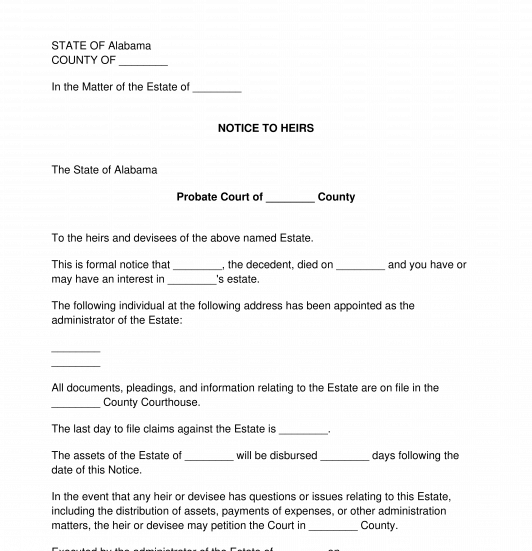 09/30/2025
09/30/2025

Answer a few questions and your document is created automatically.

Your document is ready! You will receive it in Word and PDF formats. You will be able to modify it.

 09/30/2025
09/30/2025
 Word and PDF
Word and PDF
 1 page
1 page



A Notice to Heirs is a simple document used by the administrator of an estate to notify family members, children, and others mentioned in a Last Will and Testament, that they may potentially be heirs to an estate. An estate is all of the property and money owned by a person, particularly at the time of their death. Informal probate hearings typically require the use of a notice to heirs that is mailed or delivered to each potential heir of the deceased person's estate. The notice is not a guarantee that the recipient will inherit part of the estate. Rather, the notice is used to inform potential heirs that the probate process has begun and an executor has been assigned by the court to administrate the will. This notice essentially gives potential heirs a heads up that they should pay attention to the administration of the estate and bring any outstanding claims for money owed to them that may exist. The timing of when this document is sent can be critical as a Notice to Heirs must typically be sent within a certain number of days after the executor has been assigned.
How to use this document
This document has all of the information necessary to create a brief but thorough Notice to Heirs. The notice has information about the name of the deceased person and when they died, the court who will be probating the estate, and the person who has been assigned by the court to be the executor of the will. The executor's primary job is to alert the heirs and distribute the contents of the estate as laid out in the decedent's will. The notice also includes a deadline by which anyone owed money by the decedent must file a claim against the state to be repaid their money. Finally, the notice alerts the potential heirs how many days from the mailing of the notice the executor will begin to make distributions from the estate. Requirements vary from state to state but there is generally a minimum of thirty days between when the notice is send and when the distribution of the estate begins.
Once the notice has been fully completed, the executor should print out, sign, and send as many copies as they need to alert all potential heirs to the estate. Proof of service must be obtained and later filed with the court. For this reason, these types of notices are typically mailed by certified mail with an attached Affidavit of Service as proof the notice was mailed to the heir's legal address.
Applicable law
As with all other matters relating to wills and estates, notices to heirs are controlled by state law. There are different requirements from state to state about the timing and procedures related to when and how an estate will be probated and when the notice to heirs must be sent. In some states, in addition to all heirs named in the will, the spouse and all children, whether or not they have been named in the will, must also be notified. The executor should pay careful attention to deadlines set by their state and jurisdiction. For specific guidance on who to send the notice to and when. consult with an estate planning attorney to discuss local laws.
How to modify the template
You fill out a form. The document is created before your eyes as you respond to the questions.
At the end, you receive it in Word and PDF formats. You can modify it and reuse it.
A guide to help you: How to Send a Letter
Notice to Heirs - FREE - Template - Word & PDF
Country: United States